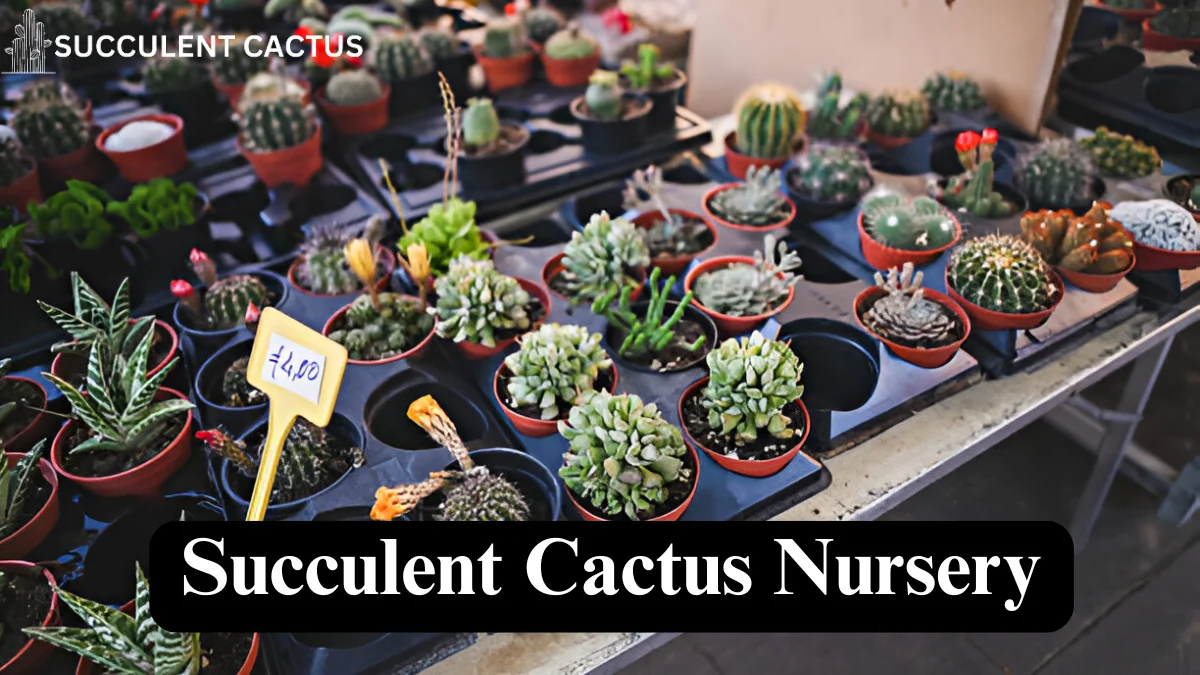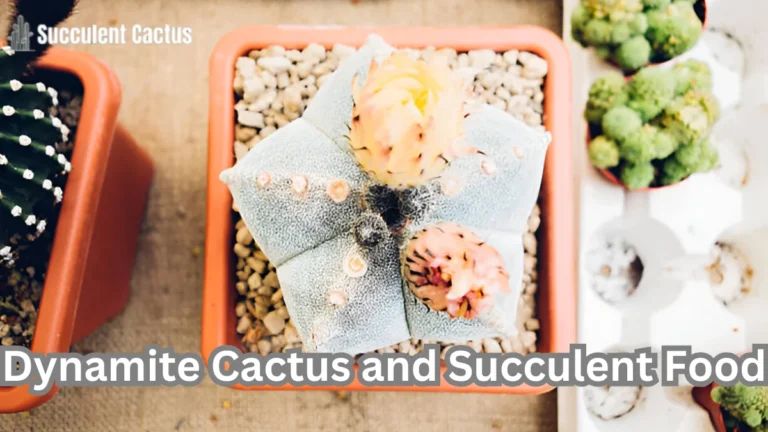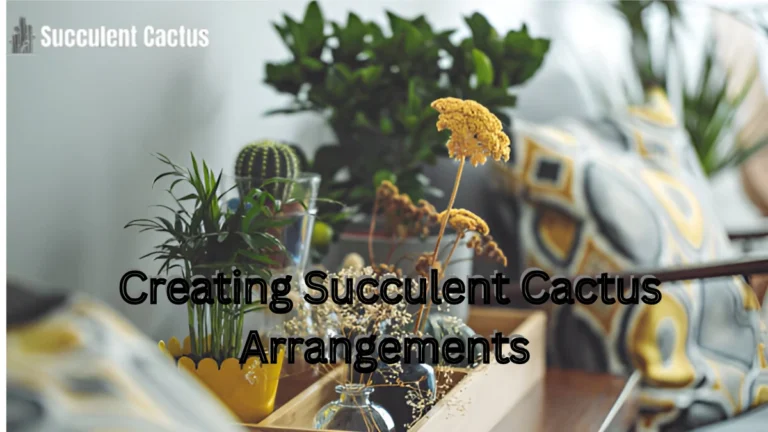Succulent Cactus Nursery: A Guide to Starting and Maintaining a Nursery

Succulents and cacti have become incredibly popular for their aesthetic appeal and low maintenance needs. Starting a succulent cactus nursery can be both rewarding and profitable. Whether you’re an enthusiast looking to grow your passion or an entrepreneur seeking opportunities, understanding the essentials of a succulent cactus nursery is crucial. In this blog, we’ll cover everything from selecting the right plants to sustainable practices, soil mixes, and marketing tips for your nursery.
Understanding Succulent Cactus Nurseries
The Role of a Nursery
Succulent cactus nurseries serve as the primary hubs for cultivating, propagating, and selling these plants to consumers, landscapers, and hobbyists. Unlike traditional plant nurseries, these facilities specialize in plants that thrive in arid conditions. Nurseries also educate customers about plant care, making them essential for promoting the growth of sustainable gardening. For entrepreneurs, nurseries offer the chance to tap into the rising demand for drought-resistant plants.
Moreover, nurseries act as biodiversity preservation centers by propagating rare and endangered succulents. Hobbyists and collectors rely on nurseries to find unique species and hybrids. Providing both common varieties and rare plants ensures that nurseries cater to diverse customer needs, from beginners to experienced growers.
Why Succulents and Cacti Are Popular
The popularity of succulents and cacti stems from their low maintenance requirements and versatility. They are excellent for urban living because they require minimal water and thrive in small spaces, such as windowsills, desks, or balconies. Their striking geometric forms and vivid colors also make them favorites for interior design.
For example, Aloe Vera doubles as both a decorative plant and a natural remedy for skin issues, making it a functional choice for households. Meanwhile, the Golden Barrel Cactus is a landscaping favorite for its dramatic spherical shape. Whether it’s for aesthetic or practical reasons, succulents and cacti have carved out a permanent niche in the gardening world.
Benefits of a Succulent Cactus Nursery
A succulent cactus nursery offers multiple advantages:
- Economic Opportunity: The profitability of succulents has increased with their rising demand.
- Eco-Friendly Gardening: Their low water usage makes them ideal for drought-prone regions.
- Diverse Applications: They are perfect for home décor, gifting, and outdoor landscaping.
By starting a nursery, you contribute to spreading sustainable gardening practices while creating a viable business opportunity.
Setting Up a Succulent Cactus Nursery
Choosing the Location
Location is one of the most important factors when starting a nursery. Succulents and cacti require plenty of sunlight, so ensure that your nursery is in a place that receives at least six hours of direct light daily. If you’re working in an area with limited natural light, invest in high-quality grow lights to support plant growth.
Additionally, ventilation is crucial. Poor airflow can lead to pest infestations and fungal diseases. Select an open space with adequate air circulation to keep plants healthy. Outdoor nurseries work well in dry, warm climates, while indoor nurseries should maintain controlled environments with temperature and humidity monitoring.
Infrastructure and Equipment
A nursery requires basic infrastructure, such as greenhouses, shade cloths, and potting tables. Greenhouses are particularly useful for protecting plants during extreme weather conditions, such as frost or heavy rains.
Essential equipment for a succulent cactus nursery includes:
- Grow Lights: Mimic natural sunlight in indoor nurseries.
- Drip Irrigation Systems: Conserve water and ensure even watering.
- Potting Tables: Facilitate planting and repotting without straining your back.
| Equipment | Purpose |
| Greenhouses | Climate control |
| Drip Irrigation | Efficient water distribution |
| Ventilation Fans | Maintain airflow in enclosed spaces |
Investment and Costs
Starting a succulent cactus nursery involves some initial costs. For a small-scale setup, expenses range from $5,000 to $10,000, covering greenhouses, equipment, starter plants, and marketing. Long-term profitability depends on consistent plant quality and customer satisfaction. Bulk purchasing of materials and propagating your plants can help reduce costs significantly.
Choosing the Right Succulent and Cactus Varieties
Popular Succulent Varieties
Some of the most sought-after succulents include:
- Echeveria: Known for its rosette-shaped leaves and pastel colors.
- Jade Plant (Crassula ovata): A symbol of good luck and prosperity.
- String of Pearls (Senecio rowleyanus): A trailing succulent with bead-like leaves.
These succulents are beginner-friendly, visually appealing and versatile for both indoor and outdoor settings. Offering these varieties in your nursery ensures you cater to a wide audience, from beginners to collectors.
Popular Cactus Varieties
Cacti are equally diverse, and some popular varieties include:
- Golden Barrel Cactus (Echinocactus grusonii): A striking centerpiece for gardens.
- Prickly Pear (Opuntia): Known for its edible fruit and decorative appeal.
- Christmas Cactus (Schlumbergera): A winter-blooming favorite.
By including both classic and unique varieties, your nursery can attract a broad customer base. Consider seasonal trends, as some cacti are more popular during holidays like Christmas.
Tips for Selecting Varieties
When choosing plants for your nursery, consider:
- Market Demand: Stock plants that are trending, such as String of Hearts or Monstera succulents.
- Climate Compatibility: Opt for plants suited to your local environment to reduce care requirements.
- Ease of Propagation: Select varieties that are easy to propagate to maximize profits.
Soil Mixes for Succulent and Cactus Nurseries
Importance of Well-Draining Soil
Proper soil is critical for healthy succulents and cacti. These plants are prone to root rot if their roots sit in water for too long. A well-draining soil mix prevents this issue, allowing excess water to flow out while retaining just enough moisture for the plant.
Ideal Ingredients for Soil Mixes
The best soil mix includes the following:
- Coarse Sand: Improves drainage.
- Perlite or Pumice: Prevents soil compaction.
- Coconut Coir or Peat Moss: Retains just enough moisture without becoming waterlogged.
| Soil Ingredient | Purpose |
| Sand | Improves drainage |
| Perlite | Enhances aeration |
| Organic Compost | Adds nutrients |
Preparing Soil Mixes at Home
You can create a simple homemade soil mix by combining equal parts sand, perlite, and potting soil. Add some organic compost for additional nutrients. Tailor your mix based on plant variety; for instance, cacti may require more sand, while succulents like Echeveria may benefit from a slightly richer mix.
Propagation Techniques in Succulent Cactus Nurseries
Leaf Propagation
Leaf propagation is one of the simplest and most effective methods to propagate succulents. This technique involves selecting healthy leaves, allowing them to callous over, and then placing them on well-draining soil to encourage root growth.
To propagate through leaves:
- Gently twist a leaf from the stem, ensuring a clean break without damaging the base.
- Let the leaf dry for 1–3 days in a shaded area to form a callous.
- Place the calloused leaf on top of a moist, well-draining soil mix.
- Mist lightly every few days, ensuring the soil stays slightly damp.
Key Tip: Not all succulents propagate well through leaves. Varieties like Echeveria and Sedum are ideal for this method, while cacti require other techniques.
Stem Cutting Propagation
Stem cuttings are an excellent way to propagate larger succulents and some cacti. This method is ideal for plants like Jade (Crassula ovata) or Pencil Cactus (Euphorbia tirucalli).
- Use a clean, sharp knife to cut a healthy stem from the mother plant.
- Allow the cutting to dry for 1–2 weeks, forming a callous at the cut end.
- Plant the stem in a pot filled with well-draining soil, and water sparingly.
Stem propagation is especially useful for rejuvenating overgrown or leggy succulents, creating a fuller appearance in your nursery displays.
Offsets and Division
Many succulents and cacti produce offsets, also known as “pups,” which can be separated from the mother plant and grown individually. Examples include Aloe Vera and Golden Barrel Cactus.
- Gently remove the offset using a knife or by hand, ensuring roots are intact.
- Allow the offset to dry for a day before planting it in fresh soil.
- Water sparingly until the plant establishes itself.
Table: Propagation Methods Comparison
| Method | Best For | Difficulty | Success Rate |
| Leaf Propagation | Echeveria, Sedum | Easy | High |
| Stem Cuttings | Jade, Pencil Cactus | Moderate | High |
| Offsets and Division | Aloe Vera, Golden Barrel | Easy | Very High |
Watering Succulents and Cacti in Nurseries
Importance of Watering Techniques
Proper watering is crucial for the health of succulents and cacti, as overwatering is the most common cause of plant failure. These plants store water in their leaves, stems, and roots, making them highly drought-tolerant.
For nurseries, develop a watering schedule that considers the plant variety, pot size, and climate. Use watering cans with narrow spouts to direct water to the soil, avoiding wetting the leaves.
Frequency of Watering
- During the growing season (spring and summer), succulents and cacti require watering every 1–2 weeks, depending on the climate.
- During the dormant season (fall and winter), reduce watering to once a month or less, as the plants grow slowly and require minimal hydration.
Key Tip: Always allow the soil to dry out completely between waterings. Check the soil moisture by inserting your finger 1–2 inches deep.
Signs of Overwatering and Underwatering
Recognizing the signs of improper watering can save your plants:
- Overwatering: Mushy, translucent leaves; root rot; and foul odors.
- Underwatering: Wrinkled or shriveled leaves and stems.
By educating customers on watering best practices, nurseries can help ensure plant success after purchase, increasing customer satisfaction and loyalty.
Lighting Requirements for Succulent Cactus Nurseries
Sunlight vs. Artificial Light
Succulents and cacti thrive in bright, indirect sunlight, but some varieties, such as Haworthia, prefer partial shade. Nurseries must strike a balance between natural and artificial lighting to ensure healthy growth.
Natural Light Tips:
- Position outdoor nurseries in areas with ample sunlight, avoiding prolonged exposure to harsh midday rays.
- Rotate plants regularly to promote even growth and prevent leaning.
For indoor nurseries, use grow lights to simulate natural sunlight. LED grow lights are energy-efficient and provide the full spectrum of light needed for photosynthesis.
Light Requirements by Plant Type
- Full Sun Succulents: Echeveria, Sedum, and Agave require at least 6 hours of direct sunlight daily.
- Partial Shade Succulents: Haworthia and Gasteria thrive in filtered light.
- Cacti: Most cacti, like Mammillaria and Ferocactus, prefer bright, direct light but can adapt to partial shade.
Table: Light Needs for Common Plants
| Plant Type | Light Requirement |
| Echeveria | Full Sun |
| Haworthia | Partial Shade |
| Golden Barrel Cactus | Bright Direct Light |
Avoiding Sunburn
Excessive sunlight can cause sunburn, leading to discolored patches on leaves. To prevent this, gradually acclimate plants to brighter light by increasing exposure over time. Use shade cloths in outdoor nurseries to diffuse harsh sunlight.
Soil Mix for Succulent Cactus Nurseries
Importance of Well-Draining Soil
The right soil mix is a critical factor in growing healthy succulents and cacti. These plants naturally grow in arid environments with sandy, well-draining soils that prevent water retention. Using regular garden soil or potting soil can suffocate roots and lead to rot.
For nurseries, always use or recommend a specialized succulent and cactus soil mix. The mix should be porous, aerated, and free of compacting materials.
Key Ingredients for Cactus and Succulent Soil Mix:
- Coarse Sand: Improves drainage and prevents waterlogging.
- Perlite or Pumice: Enhances aeration and reduces soil compaction.
- Organic Material: A small amount of peat moss or coconut coir retains minimal moisture for root absorption.
Customizing Soil for Different Varieties
Not all succulents and cacti require the same soil composition. Adjust the mix based on the plant’s natural habitat:
- Desert Cacti: Prefer gritty soil with higher proportions of sand and pumice.
- Tropical Succulents: Need slightly more organic material to retain some moisture.
Tips for Nursery Owners
- Mix your soil in large batches to maintain consistency across pots.
- Offer pre-packaged soil mixes to customers, complete with labels detailing the ingredients and their benefits.
- Regularly check the pH of the soil, which should be slightly acidic (between 5.5 and 6.5).
Table: Example of a Basic Succulent and Cactus Soil Recipe
| Ingredient | Proportion |
| Coarse Sand | 50% |
| Pumice or Perlite | 30% |
| Organic Material | 20% |
Seasonal Care Tips for Succulents and Cacti
Spring Care Tips
Spring marks the active growing season for most succulents and cacti. During this time:
- Watering: Increase watering frequency slightly, ensuring soil dries between sessions.
- Repotting: Repot plants that have outgrown their containers. Use fresh soil to replenish nutrients.
- Fertilizing: Apply a balanced, diluted succulent fertilizer every 4–6 weeks.
Spring is also the best time to propagate plants, as growth hormones are most active.
Summer Care Tips
Summer’s intense heat can stress succulents and cacti if not managed properly.
- Sun Protection: Use shade cloths or move plants to partial shade during the hottest parts of the day.
- Watering: Water early in the morning to reduce evaporation and allow the roots to absorb moisture.
- Pest Control: Inspect plants regularly for pests like mealybugs, which tend to appear in warm weather.
Winter Dormancy Care
During winter, most succulents and cacti enter dormancy. Their growth slows significantly, and they require minimal care.
- Watering: Cut back on watering to once a month or less.
- Lighting: Move indoor plants closer to windows to maximize available sunlight.
- Temperature: Protect plants from frost by covering outdoor plants or bringing pots indoors.
Seasonal Checklist for Nurseries
| Season | Key Tasks |
| Spring | Propagation, fertilizing, repotting |
| Summer | Sun protection, pest control |
| Winter | Reduce watering, frost protection |
Packaging and Presentation in Nurseries
Attractive Plant Displays
Displaying succulents and cacti in eye-catching arrangements can increase sales. Use tiered shelving to maximize space and showcase plants at various heights. Group plants by color, size, or type to help customers visualize their garden layouts.
Include detailed labels for each plant, highlighting:
- Common and scientific names.
- Watering and light requirements.
- Growth habits (size and shape).
Pro Tip: Create themed collections like “Low-Light Succulents” or “Pet-Safe Cacti” to appeal to niche customers.
Eco-Friendly Packaging
Modern customers are drawn to sustainable practices. Offer biodegradable pots, recycled packaging materials, and reusable plant bags. Avoid using excessive plastic wraps.
Gift-Ready Options
Succulents and cacti make excellent gifts. Design aesthetically pleasing packaging for special occasions, such as:
- Decorative pots with bows.
- Miniature arrangements in glass terrariums.
- DIY kits with soil, pots, and care instructions.
Marketing Strategies for Succulent Cactus Nurseries
Leveraging Social Media
Social media platforms like Instagram and Pinterest are perfect for showcasing visually appealing plants. Post high-quality images and videos, including:
- Before-and-after repotting transformations.
- Unique plant arrangements and decorations.
- Care tips and propagation tutorials.
Use hashtags like #SucculentLove, #CactusNursery, and #PlantParenthood to reach a wider audience.
Hosting Workshops
Offer in-person or virtual workshops on topics like:
- “Caring for Indoor Succulents.”
- “Designing Cactus Terrariums.”
- “DIY Propagation Techniques.”
These events can drive traffic to your nursery and build long-term customer relationships.
Partnering with Local Businesses
Collaborate with florists, interior designers, or garden centers to cross-promote products. Provide small succulents as part of wedding or event decor packages to reach new audiences.
Common Challenges in Managing a Nursery
Pest Infestations
Pests like mealybugs, spider mites, and scale insects can harm plants and spread quickly in nurseries. Regularly inspect plants, isolate affected ones, and use organic insecticides for treatment.
Overwatering by Customers
Educating customers on proper watering techniques can reduce plant returns. Include detailed care instructions with every sale.
Climate Control
Maintaining optimal temperature and humidity levels in the nursery is essential for plant health. Use fans, heaters, and dehumidifiers to create a stable environment.
FAQs
- What’s the best soil for succulents and cacti?
A well-draining soil mix containing coarse sand, pumice, and a small amount of organic matter works best. - How often should I water succulents and cacti?
Water every 1–2 weeks in the growing season and once a month during dormancy. - Can I grow succulents indoors?
Yes, but they need bright, indirect light. Consider using grow lights if natural sunlight is limited. - What’s the easiest way to propagate succulents?
Leaf propagation is simple and works well for plants like Echeveria. - How do I prevent pests in my nursery?
Regular inspections, proper watering, and organic pest control methods can keep infestations under control.
Conclusion
Running a succulent cactus nursery is both rewarding and profitable, provided you invest in the right practices. From creating the perfect soil mix to educating customers on care techniques, every detail contributes to success. By focusing on sustainable practices, beautiful packaging, and effective marketing, you can stand out in this thriving industry. Whether you’re a beginner or an experienced plant enthusiast, the knowledge shared here will help you grow a thriving nursery and bring joy to countless plant lovers.






